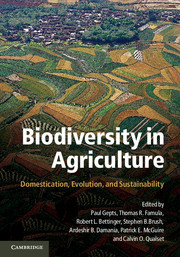Book contents
- Frontmatter
- Contents
- Tables
- Figures
- Foreword
- Contributors
- Acknowledgments
- Introduction: The Domestication of Plants and Animals: Ten Unanswered Questions
- 1 The Local Origins of Domestication
- Section I Early Steps in Agricultural Domestication
- Section II Domestication of Animals and Impacts on Humans
- 9 Pathways to Animal Domestication
- 10 Genetics of Animal Domestication
- 11 Genome-Wide Approaches for the Study of Dog Domestication
- 12 Malaria and Rickets Represent Selective Forces for the Convergent Evolution of Adult Lactase Persistence
- Section III Issues in Plant Domestication
- Section IV Traditional Management of Biodiversity
- Section V Uses of Biodiversity and New and Future Domestications
- Index
- References
10 - Genetics of Animal Domestication
Published online by Cambridge University Press: 05 June 2012
- Frontmatter
- Contents
- Tables
- Figures
- Foreword
- Contributors
- Acknowledgments
- Introduction: The Domestication of Plants and Animals: Ten Unanswered Questions
- 1 The Local Origins of Domestication
- Section I Early Steps in Agricultural Domestication
- Section II Domestication of Animals and Impacts on Humans
- 9 Pathways to Animal Domestication
- 10 Genetics of Animal Domestication
- 11 Genome-Wide Approaches for the Study of Dog Domestication
- 12 Malaria and Rickets Represent Selective Forces for the Convergent Evolution of Adult Lactase Persistence
- Section III Issues in Plant Domestication
- Section IV Traditional Management of Biodiversity
- Section V Uses of Biodiversity and New and Future Domestications
- Index
- References
Summary
Domestic animals show an amazing phenotypic diversity in form, color, behavior, and as regards their adaptation to various environments and production systems (Figure 10.1). Domestication took place 5,000 to 10,000 years ago for the major species of domestic animals and probably even earlier than that for the dog. It is now an exciting time for studying the evolutionary history of animal domestication thanks to the development of powerful tools for genetic analysis. We are now in a position where we can identify major genetic changes associated with domestication. This research is not only of interest for its own sake but it is also of general interest as a model for evolutionary biology and it will lead to new knowledge concerning gene function and genotype–phenotype relationships of interest for human medicine. Considerable progress has been made in the past 10 years as regards when and where animal domestications took place (Giuffra et al. 2000, Vilà et al. 2001, Savolainen et al. 2002, Bruford et al. 2003, Larson et al. 2005). However, the aim of this paper is to discuss how the genetic basis for phenotypic evolution in domestic animals can be revealed and how far we have come in this process and to give two examples where the alleles underlying phenotypic traits not present in the wild ancestor have been identified.
Most genetic diversity pre-dates domestication
A common misconception about domestic animals is that they are highly inbred. That is true if one considers certain breeds; in particular, the dog is subdivided into many small populations that are more or less inbred. However, across populations of domestic animals there is an extensive amount of genetic diversity at the DNA level. For instance, a pair of chicken chromosomes shows on average 5 sequence differences per 1,000 base pairs (International Chicken Polymorphism Map Consortium 2004). The corresponding figure for humans is only 1 difference per 1,000 base pairs. Other species of domestic animals show nucleotide sequence diversities in the same range as humans do.
- Type
- Chapter
- Information
- Biodiversity in AgricultureDomestication, Evolution, and Sustainability, pp. 260 - 274Publisher: Cambridge University PressPrint publication year: 2012
References
- 1
- Cited by



